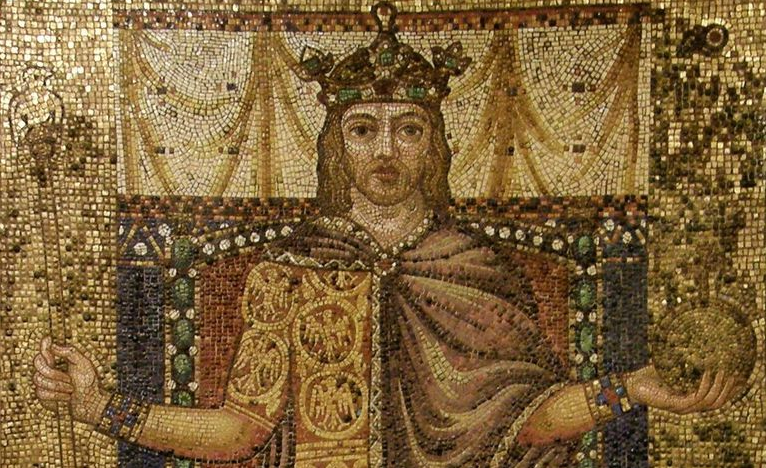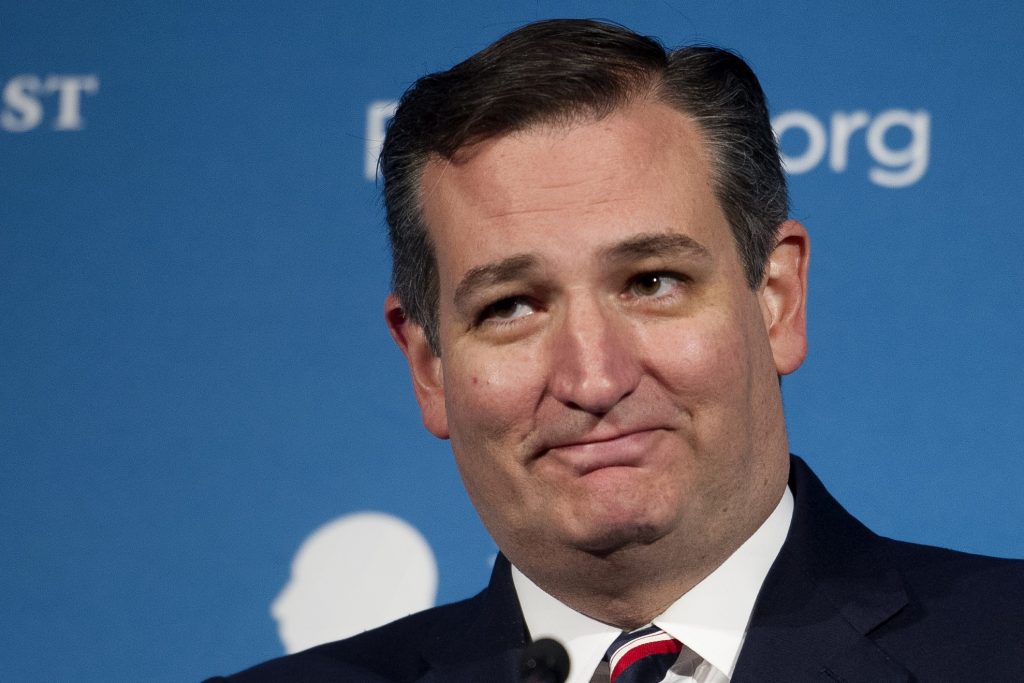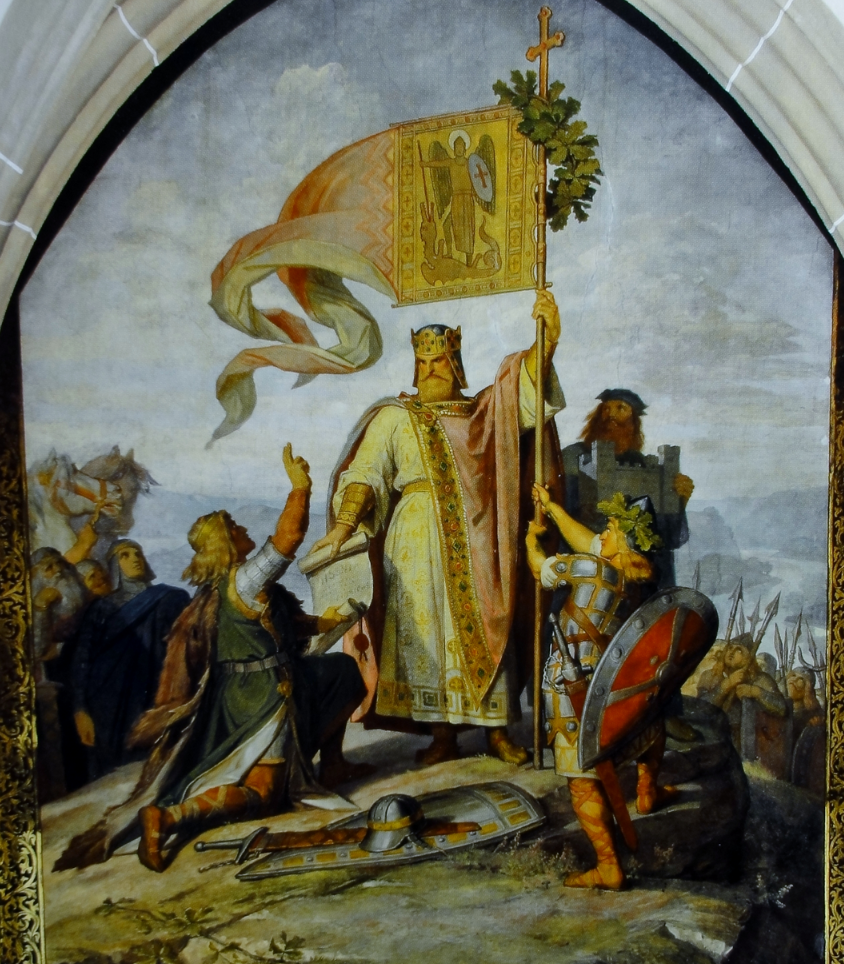Editor’s Note: The following comprises the seventh chapter of The Holy Roman Empire, by James Bryce (published 1871). All spelling in the original.
(Continued from Part 6)
CHAPTER VII
THEORY OF THE MEDIÆVAL EMPIRE
Why the revival of the Empire was desired
These were the events and circumstances of the time: let us now look at the causes. The restoration of the Empire by Charles may seem to be sufficiently accounted for by the width of his conquests, by the peculiar connection which already subsisted between him and the Roman Church, by his commanding personal character, by the temporary vacancy of the Byzantine throne. The causes of its revival under Otto must be sought deeper. Making every allowance for the favouring incidents which have already been dwelt upon, there must have been some further influence at work to draw him and his successors, Saxon and Frankish kings, so far from home in pursuit of a barren crown, to lead the Italians to accept the dominion of a stranger and a barbarian, to make the Empire itself appear through the whole Middle Age not what it seems now, a gorgeous anachronism, but an institution divine and necessary, having its foundations in the very nature and order of things. The empire of the elder Rome had been splendid in its life, yet its judgment was written in the misery to which it had brought the provinces, and the helplessness that had invited the attacks of the barbarian. Now, as we at least can see, it had long been dead, and the course of events was adverse to its revival. Its actual representatives, the Roman people, were a turbulent rabble, sunk in a profligacy notorious even in that guilty age. Yet not the less for all this did men cling to the idea, and strive through long ages to stem the irresistible time-current, fondly believing that they were breasting it even while it was sweeping them ever faster and faster away from the old order into a region of new thoughts, new feelings, new forms of life. Not till the days of the Reformation was the illusion dispelled.
Mediæval theories
The explanation is to be found in the state of the human mind during these centuries. The Middle Ages were essentially unpolitical. Ideas as familiar to the commonwealths of antiquity as to ourselves, ideas of the common good as the object of the State, of the rights of the people, of the comparative merits of different forms of government, were to them, though sometimes carried out in fact, in their speculative form unknown, perhaps incomprehensible. Feudalism was the one great institution to which those times gave birth, and feudalism was a social and a legal system, only indirectly and by consequence a political one. Yet the human mind, so far from being idle, was in certain directions never more active; nor was it possible for it to remain without general conceptions regarding the relation of men to each other in this world. Such conceptions were neither made an expression of the actual present condition of things nor drawn from an induction of the past; they were partly inherited from the system that had preceded, partly evolved from the principles of that metaphysical theology which was ripening into scholasticism. Now the two great ideas which expiring antiquity bequeathed to the ages that followed were those of a World-Monarchy and a World-Religion.
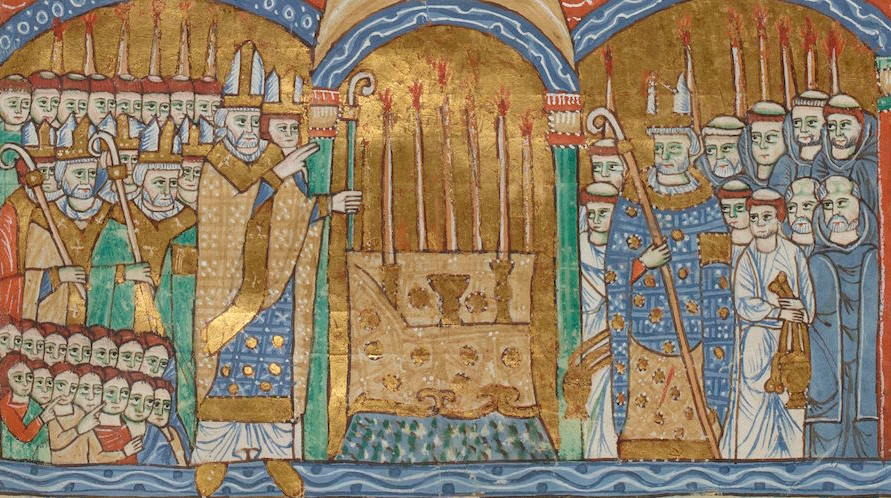
The World-Religion
Before the conquests of Rome, men, with little knowledge of each other, with no experience of wide political union, had held differences of race to be natural and irremovable barriers. Similarly, religion appeared to them a matter purely local and national; and as there were gods of the hills and gods of the valleys, of the land and of the sea, so each tribe rejoiced in its peculiar deities, looking on the natives of another country who worshipped other gods as Gentiles, natural foes, unclean beings. Such feelings, if keenest in the East, frequently shew themselves in the early records of Greece and Italy: in Homer the hero who wanders over the unfruitful sea glories in sacking the cities of the stranger; the primitive Latins have the same word for a foreigner and an enemy: the exclusive systems of Egypt, Hindostan, China, are only more vehement expressions of the belief which made Athenian philosophers look on a state of war between Greeks and barbarians as natural, and defend slavery on the same ground of the original diversity of the races that rule and the races that serve. The Roman dominion giving to many nations a common speech and law, smote this feeling on its political side; Christianity more effectually banished it from the soul by substituting for the variety of local pantheons the belief in one God, before whom all men are equal.
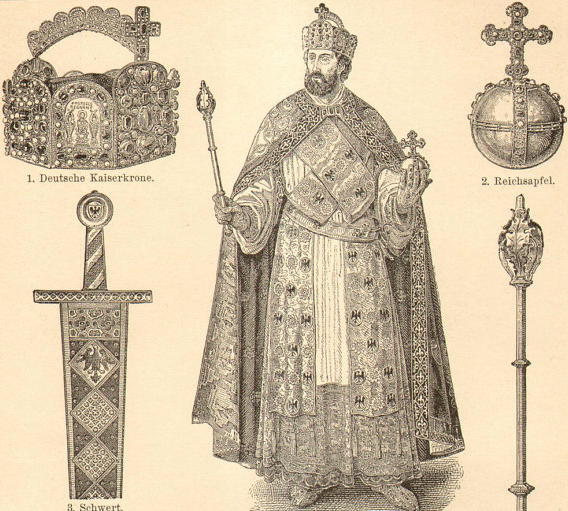
Coincides with the World-Empire
It is on the religious life that nations repose. Because divinity was divided, humanity had been divided likewise; the doctrine of the unity of God now enforced the unity of man, who had been created in His image. The first lesson of Christianity was love, a love that was to join in one body those whom suspicion and prejudice and pride of race had hitherto kept apart. There was thus formed by the new religion a community of the faithful, a Holy Empire, designed to gather all men into its bosom, and standing opposed to the manifold polytheisms of the older world, exactly as the universal sway of the Cæsars was contrasted with the innumerable kingdoms and republics that had gone before it. The analogy of the two made them appear parts of one great world-movement toward unity: the coincidence of their boundaries, which had begun before Constantine, lasted long enough after him to associate them indissolubly together, and make the names of Roman and Christian convertible. Œcumenical councils, where the whole spiritual body gathered itself from every part of the temporal realm under the presidency of the temporal head, presented the most visible and impressive examples of their connection. The language of civil government was, throughout the West, that of the sacred writings and of worship; the greatest mind of his generation consoled the faithful for the fall of their earthly commonwealth Rome, by describing to them its successor and representative, the ‘city which hath foundations, whose builder and maker is God.’
Preservation of the unity of the Church
Of these two parallel unities, that of the political and that of the religious society, meeting in the higher unity of all Christians, which may be indifferently called Catholicity or Romanism (since in that day those words would have had the same meaning), that only which had been entrusted to the keeping of the Church survived the storms of the fifth century. Many reasons may be assigned for the firmness with which she clung to it. Seeing one institution after another falling to pieces around her, seeing how countries and cities were being severed from each other by the irruption of strange tribes and the increasing difficulty of communication, she strove to save religious fellowship by strengthening the ecclesiastical organization, by drawing tighter every bond of outward union. Necessities of faith were still more powerful. Truth, it was said, is one, and as it must bind into one body all who hold it, so it is only by continuing in that body that they can preserve it.
Mediæval Theology requires One Visible Catholic Church
Thus with the growing rigidity of dogma, which may be traced from the council of Jerusalem to the council of Trent, there had arisen the idea of supplementing revelation by tradition as a source of doctrine, of exalting the universal conscience and belief above the individual, and allowing the soul to approach God only through the universal consciousness, represented by the sacerdotal order: principles still maintained by one branch of the Church, and for some at least of which far weightier reasons could be assigned then, in the paucity of written records and the blind ignorance of the mass of the people, than any to which their modern advocates have recourse. There was another cause yet more deeply seated, and which it is hard adequately to describe. It was not exactly a want of faith in the unseen, nor a shrinking fear which dared not look forth on the universe alone: it was rather the powerlessness of the untrained mind to realize the idea as an idea and live in it: it was the tendency to see everything in the concrete, to turn the parable into a fact, the doctrine into its most literal application, the symbol into the essential ceremony; the tendency which intruded earthly Madonnas and saints between the worshipper and the spiritual Deity, and could satisfy its devotional feelings only by visible images even of these: which conceived of man’s aspirations and temptations as the result of the direct action of angels and devils: which expressed the strivings of the soul after purity by the search for the Holy Grail: which in the Crusades sent myriads to win at Jerusalem by earthly arms the sepulchre of Him whom they could not serve in their own spirit nor approach by their own prayers. And therefore it was that the whole fabric of mediæval Christianity rested upon the idea of the Visible Church. Such a Church could be in nowise local or limited. To acquiesce in the establishment of National Churches would have appeared to those men, as it must always appear when scrutinized, contradictory to the nature of a religious body, opposed to the genius of Christianity, defensible, when capable of defence at all, only as a temporary resource in the presence of insuperable difficulties. Had this plan, on which so many have dwelt with complacency in later times, been proposed either to the primitive Church in its adversity or to the dominant Church of the ninth century, it would have been rejected with horror; but since there were as yet no nations, the plan was one which did not and could not present itself. The Visible Church was therefore the Church Universal, the whole congregation of Christian men dispersed throughout the world.
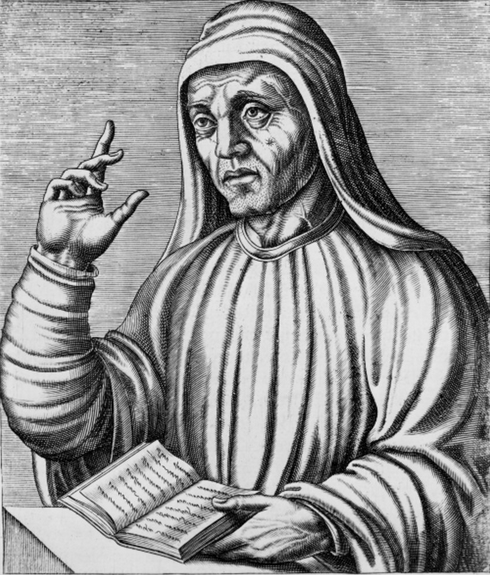
Idea of political unity upheld by the clergy
Now of the Visible Church the emblem and stay was the priesthood; and it was by them, in whom dwelt whatever of learning and thought was left in Europe, that the second great idea whereof mention has been made—the belief in one universal temporal state—was preserved. As a matter of fact, that state had perished out of the West, and it might seem their interest to let its memory be lost. They, however, did not so calculate their interest. So far from feeling themselves opposed to the civil authority in the seventh and eighth centuries, as they came to do in the twelfth and thirteenth, the clergy were fully persuaded that its maintenance was indispensable to their own welfare. They were, be it remembered, at first Romans themselves living by the Roman law, using Latin as their proper tongue, and imbued with the idea of the historical connection of the two powers. And by them chiefly was that idea expounded and enforced for many generations, by none more earnestly than by Alcuin of York, the adviser of Charles. The limits of those two powers had become confounded in practice: bishops were princes, the chief ministers of the sovereign, sometimes even the leaders of their flocks in war: kings were accustomed to summon ecclesiastical councils, and appoint to ecclesiastical offices.
Influence of the metaphysics of the time upon the theory of a World-State
But, like the unity of the Church, the doctrine of a universal monarchy had a theoretical as well as an historical basis, and may be traced up to those metaphysical ideas out of which the system we call Realism developed itself. The beginnings of philosophy in those times were logical; and its first efforts were to distribute and classify: system, subordination, uniformity, appeared to be that which was most desirable in thought as in life. The search after causes became a search after principles of classification; since simplicity and truth were held to consist not in an analysis of thought into its elements, nor in an observation of the process of its growth, but rather in a sort of genealogy of notions, a statement of the relations of classes as containing or excluding each other. These classes, genera or species, were not themselves held to be conceptions formed by the mind from phenomena, nor mere accidental aggregates of objects grouped under and called by some common name; they were real things, existing independently of the individuals who composed them, recognized rather than created by the human mind. In this view, Humanity is an essential quality present in all men, and making them what they are: as regards it they are therefore not many but one, the differences between individuals being no more than accidents. The whole truth of their being lies in the universal property, which alone has a permanent and independent existence. The common nature of the individuals thus gathered into one Being is typified in its two aspects, the spiritual and the secular, by two persons, the World-Priest and the World-Monarch, who present on earth a similitude of the Divine unity. For, as we have seen, it was only through its concrete and symbolic expression that a thought could then be apprehended. Although it was to unity in religion that the clerical body was both by doctrine and by practice attached, they found this inseparable from the corresponding unity in politics. They saw that every act of man has a social and public as well as a moral and personal bearing, and concluded that the rules which directed and the powers which rewarded or punished must be parallel and similar, not so much two powers as different manifestations of one and the same. That the souls of all Christian men should be guided by one hierarchy, rising through successive grades to a supreme head, while for their deeds they were answerable to a multitude of local, unconnected, mutually irresponsible potentates, appeared to them necessarily opposed to the Divine order. As they could not imagine, nor value if they had imagined, a communion of the saints without its expression in a visible Church, so in matters temporal they recognized no brotherhood of spirit without the bonds of form, no universal humanity save in the image of a universal State. In this, as in so much else, the men of the Middle Ages were the slaves of the letter, unable, with all their aspirations, to rise out of the concrete, and prevented by the very grandeur and boldness of their conceptions from carrying them out in practice against the enormous obstacles that met them.
The ideal state supposed to be embodied in the Roman Empire
Deep as this belief had struck its roots, it might never have risen to maturity nor sensibly affected the progress of events, had it not gained in the pre-existence of the monarchy of Rome a definite shape and a definite purpose. It was chiefly by means of the Papacy that this came to pass. When under Constantine the Christian Church was framing her organization on the model of the state which protected her, the bishop of the metropolis perceived and improved the analogy between himself and the head of the civil government. The notion that the chair of Peter was the imperial throne of the Church had dawned upon the Popes very early in their history, and grew stronger every century under the operation of causes already specified. Even before the Empire of the West had fallen, St. Leo the Great could boast that to Rome, exalted by the preaching of the chief of the Apostles to be a holy nation, a chosen people, a priestly and royal city, there had been appointed a spiritual dominion wider than her earthly sway. In A.D. 476 Rome ceased to be the political capital of the Western countries, and the Papacy, inheriting no small part of the Emperor’s power, drew to herself the reverence which the name of the city still commanded, until by the middle of the eighth, or, at latest, of the ninth century she had perfected in theory a scheme which made her the exact counterpart of the departed despotism, the centre of the hierarchy, absolute mistress of the Christian world.
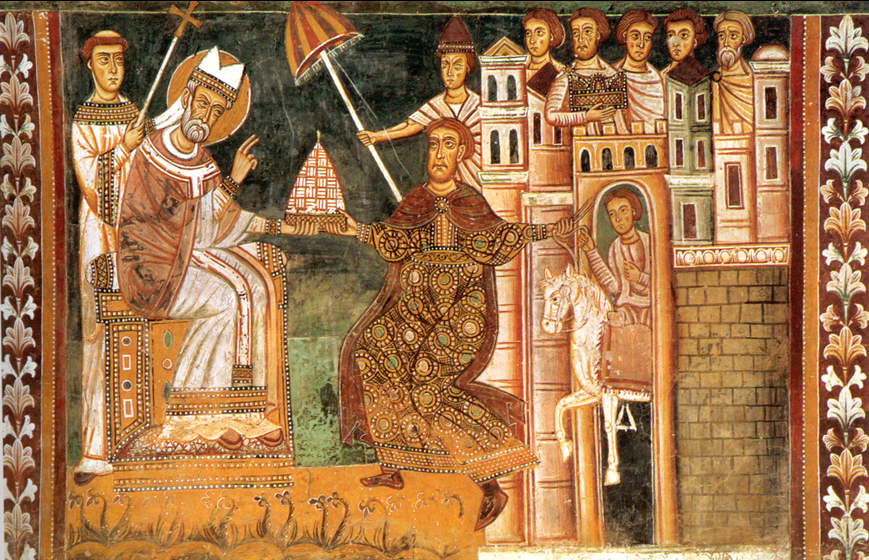
Constantine’s Donation
The character of that scheme is best set forth in the singular document, most stupendous of all the mediæval forgeries, which under the name of the Donation of Constantine commanded for seven centuries the unquestioning belief of mankind. Itself a portentous falsehood, it is the most unimpeachable evidence of the thoughts and beliefs of the priesthood which framed it, some time between the middle of the eighth and the middle of the tenth century. It tells how Constantine the Great, cured of his leprosy by the prayers of Sylvester, resolved, on the fourth day from his baptism, to forsake the ancient seat for a new capital on the Bosphorus, lest the continuance of the secular government should cramp the freedom of the spiritual, and how he bestowed therewith upon the Pope and his successors the sovereignty over Italy and the countries of the West. But this is not all, although this is what historians, in admiration of its splendid audacity, have chiefly dwelt upon. The edict proceeds to grant to the Roman pontiff and his clergy a series of dignities and privileges, all of them enjoyed by the Emperor and his senate, all of them shewing the same desire to make the pontifical a copy of the imperial office. The Pope is to inhabit the Lateran palace, to wear the diadem, the collar, the purple cloak, to carry the sceptre, and to be attended by a body of chamberlains. Similarly his clergy are to ride on white horses and receive the honours and immunities of the senate and patricians.
Interdependence of Papacy and Empire
The notion which prevails throughout, that the chief of the religious society must be in every point conformed to his prototype the chief of the civil, is the key to all the thoughts and acts of the Roman clergy; not less plainly seen in the details of papal ceremonial than it is in the gigantic scheme of papal legislation. The Canon law was intended by its authors to reproduce and rival the imperial jurisprudence; a correspondence was traced between its divisions and those of the Corpus Juris Civilis, and Gregory IX, who was the first to consolidate it into a code, sought the fame and received the title of the Justinian of the Church. But the wish of the clergy was always, even in the weakness or hostility of the temporal power, to imitate and rival, not to supersede it; since they held it the necessary complement of their own, and thought the Christian people equally imperilled by the fall of either. Hence the reluctance of Gregory II to break with the Byzantine princes, and the maintenance of their titular sovereignty till A.D. 800: hence the part which the Holy See played in transferring the crown to Charles, the first sovereign of the West capable of fulfilling its duties; hence the grief with which its weakness under his successors was seen, the gladness when it descended to Otto as representative of the Frankish kingdom.
The Roman Empire revived in a new character
Up to the era of A.D. 800 there had been at Constantinople a legitimate historical prolongation of the Roman Empire. Technically, as we have seen, the election of Charles, after the deposition of Constantine VI, was itself a prolongation, and maintained the old rights and forms in their integrity. But the Pope, though he knew it not, did far more than effect a change of dynasty when he rejected Irene and crowned the barbarian chief. Restorations are always delusive. As well might one hope to stop the earth’s course in her orbit as to arrest that ceaseless change and movement in human affairs which forbids an old institution, suddenly transplanted into a new order of things, from filling its ancient place and serving its former ends. The dictatorship at Rome in the second Punic war was not more unlike the dictatorships of Sulla and Cæsar, nor the States-general of Louis XIII to the assembly which his unhappy descendant convoked in 1789, than was the imperial office of Theodosius to that of Charles the Frank; and the seal, ascribed to A.D. 800, which bears the legend ‘Renovatio Romani Imperii,’ expresses, more justly perhaps than was intended by its author, a second birth of the Roman Empire.
It is not, however, from Carolingian times that a proper view of this new creation can be formed. That period was one of transition, of fluctuation and uncertainty, in which the office, passing from one dynasty and country to another, had not time to acquire a settled character and claims, and was without the power that would have enabled it to support them. From the coronation of Otto the Great a new period begins, in which the ideas that have been described as floating in men’s minds took clearer shape, and attached to the imperial title a body of definite rights and definite duties. It is this new phase, the Holy Empire, that we have now to consider.
Position and functions of the Emperor
The realistic philosophy, and the needs of a time when the only notion of civil or religious order was submission to authority, required the World-State to be a monarchy; tradition, as well as the continuance of certain institutions, gave the monarch the name of Roman Emperor. A king could not be universal sovereign, for there were many kings: the Emperor must be, for there had never been but one Emperor; he had in older and brighter days been the actual lord of the civilized world; the seat of his power was placed beside that of the spiritual autocrat of Christendom. His functions will be seen most clearly if we deduce them from the leading principle of mediæval mythology, the exact correspondence of earth and heaven. As God, in the midst of the celestial hierarchy, ruled blessed spirits in paradise, so the Pope, His Vicar, raised above priests, bishops, metropolitans, reigned over the souls of mortal men below. But as God is Lord of earth as well as of heaven, so must he (the Imperator cœlestis) be represented by a second earthly viceroy, the Emperor (Imperator terrenus), whose authority shall be of and for this present life. And as in this present world the soul cannot act save through the body, while yet the body is no more than an instrument and means for the soul’s manifestation, so must there be a rule and care of men’s bodies as well as of their souls, yet subordinated always to the well-being of that which is the purer and the more enduring. It is under the emblem of soul and body that the relation of the papal and imperial power is presented to us throughout the Middle Ages.
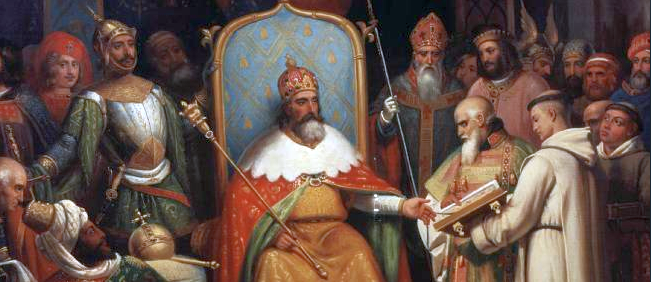
Correspondence and harmony of the spiritual and temporal powers
The Pope, as God’s vicar in matters spiritual, is to lead men to eternal life; the Emperor, as vicar in matters temporal, must so control them in their dealings with one another that they may be able to pursue undisturbed the spiritual life, and thereby attain the same supreme and common end of everlasting happiness. In the view of this object his chief duty is to maintain peace in the world, while towards the Church his position is that of Advocate, a title borrowed from the practice adopted by churches and monasteries of choosing some powerful baron to protect their lands and lead their tenants in war. The functions of Advocacy are twofold: at home to make the Christian people obedient to the priesthood, and to execute their decrees upon heretics and sinners; abroad to propagate the faith among the heathen, not sparing to use carnal weapons. Thus does the Emperor answer in every point to his antitype the Pope, his power being yet of a lower rank, created on the analogy of the papal, as the papal itself had been modelled after the elder Empire. The parallel holds good even in its details; for just as we have seen the churchman assuming the crown and robes of the secular prince, so now did he array the Emperor in his own ecclesiastical vestments, the stole and the dalmatic, gave him a clerical as well as a sacred character, removed his office from all narrowing associations of birth or country, inaugurated him by rites every one of which was meant to symbolize and enjoin duties in their essence religious. Thus the Holy Roman Church and the Holy Roman Empire are one and the same thing, in two aspects; and Catholicism, the principle of the universal Christian society, is also Romanism; that is, rests upon Rome as the origin and type of its universality; manifesting itself in a mystic dualism which corresponds to the two natures of its Founder. As divine and eternal, its head is the Pope, to whom souls have been entrusted; as human and temporal, the Emperor, commissioned to rule men’s bodies and acts.
Union of Church and State
In nature and compass the government of these two potentates is the same, differing only in the sphere of its working; and it matters not whether we call the Pope a spiritual Emperor or the Emperor a secular Pope. Nor, though the one office is below the other as far as man’s life on earth is less precious than his life hereafter, is therefore, on the older and truer theory, the imperial authority delegated by the papal. For, as has been said already, God is represented by the Pope not in every capacity, but only as the ruler of spirits in heaven: as sovereign of earth, He issues His commission directly to the Emperor. Opposition between two servants of the same King is inconceivable, each being bound to aid and foster the other: the co-operation of both being needed in all that concerns the welfare of Christendom at large. This is the one perfect and self-consistent scheme of the union of Church and State;. for, taking the absolute coincidence of their limits to be self-evident, it assumes the infallibility of their joint government, and derives, as a corollary from that infallibility, the duty of the civil magistrate to root out heresy and schism no less than to punish treason and rebellion. It is also the scheme which, granting the possibility of their harmonious action, places the two powers in that relation which gives each of them its maximum of strength. But by a law to which it would be hard to find exceptions, in proportion as the State became more Christian, the Church, who to work out her purposes had assumed worldly forms, became by the contact worldlier, meaner, spiritually weaker; and the system which Constantine founded amid such rejoicings, which culminated so triumphantly in the Empire Church of the Middle Ages, has in each succeeding generation been slowly losing ground, has seen its brightness dimmed and its completeness marred, and sees now those who are most zealous on behalf of its surviving institutions feebly defend or silently desert the principle upon which all must rest.
The complete accord of the papal and imperial powers which this theory, as sublime as it is impracticable, requires, was attained only at a few points in their history. It was finally supplanted by another view of their relation, which, professing to be a development of a principle recognized as fundamental, the superior importance of the religious life, found increasing favour in the eyes of fervent churchmen. Declaring the Pope sole representative on earth of the Deity, it concluded that from him, and not directly from God, must the Empire be held—held feudally, it was said by many—and it thereby thrust down the temporal power, to be the slave instead of the sister of the spiritual. Nevertheless, the Papacy in her meridian, and under the guidance of her greatest minds, of Hildebrand, of Alexander, of Innocent, not seeking to abolish or absorb the civil government, required only its obedience, and exalted its dignity against all save herself. It was reserved for Boniface VIII, whose extravagant pretensions betrayed the decay that was already at work within, to show himself to the crowding pilgrims at the jubilee of A.D. 1300, seated on the throne of Constantine, arrayed with sword, and crown, and sceptre, shouting aloud, ‘I am Cæsar—I am Emperor.’
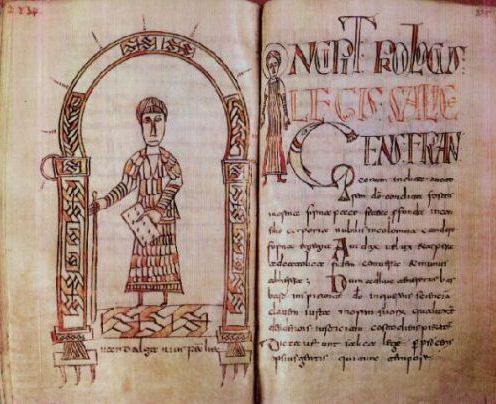
Proofs from mediæval documents
The theory of an Emperor’s place and functions thus sketched cannot be definitely assigned to any point of time; for it was growing and changing from the fifth century to the fifteenth. Nor need it surprise us that we do not find in any one author a statement of the grounds whereon it rested, since much of what seems strangest to us was then too obvious to be formally explained. No one, however, who examines mediæval writings can fail to perceive, sometimes from direct words, oftener from allusions or assumptions, that such ideas as these are present to the minds of the authors. That which it is easiest to prove is the connection of the Empire with religion. From every record, from chronicles and treatises, proclamations, laws, and sermons, passages may be adduced wherein the defence and spread of the faith, and the maintenance of concord among the Christian people, are represented as the function to which the Empire has been set apart. The belief expressed by Lewis II, ‘Imperii dignitas non in vocabuli voce sed in gloriosæ pietatis culmine consistit,’ appears again in the address of the Archbishop of Mentz to Conrad II, as Vicar of God; is reiterated by Frederick I, when he writes to the prelates of Germany, ‘On earth God has placed no more than two powers, and as there is in heaven but one God, so is there here one Pope and one Emperor. Divine providence has specially appointed the Roman Empire to prevent the continuance of schism in the Church;’ is echoed by jurists and divines down to the days of Charles V. It was a doctrine which we shall find the friends and foes of the Holy See equally concerned to insist on, the one to make the transference (translatio) from the Greeks to the Germans appear entirely the Pope’s work, and so establish his right of overseeing or cancelling his rival’s election, the others by setting the Emperor at the head of the Church to reduce the Pope to the place of chief bishop of his realm. His headship was dwelt upon chiefly in the two duties already noticed. As the counterpart of the Mussulman Commander of the Faithful, he was leader of the Church militant against her infidel foes, was in this capacity summoned to conduct crusades, and in later times recognized chief of the confederacies against the conquering Ottomans. As representative of the whole Christian people, it belonged to him to convoke General Councils, a right not without importance even when exercised concurrently with the Pope, but far more weighty when the object of the council was to settle a disputed election, or, as at Constance, to depose the reigning pontiff himself.
The Coronation ceremonies
No better illustrations can be desired than those to be found in the office for the imperial coronation at Rome, too long to be transcribed here, but well worthy of an attentive study. The rites prescribed in it are rights of consecration to a religious office: the Emperor, besides the sword, globe, and sceptre of temporal power, receives a ring as the symbol of his faith, is ordained a subdeacon, assists the Pope in celebrating mass, partakes as a clerical person of the communion in both kinds, is admitted a canon of St. Peter and St. John Lateran. The oath to be taken by an elector begins, ‘Ego N. volo regem Romanorum in Cæsarem promovendum, temporale caput populo Christiano eligere.’ The Emperor swears to cherish and defend the Holy Roman Church and her bishop: the Pope prays after the reading of the Gospel, ‘Deus qui ad prædicandum æterni regni evangelium Imperium Romanum præparasti, prætende famulo tuo Imperatori nostro arma cœlestia.’ Among the Emperor’s official titles there occur these: ‘Head of Christendom,’ ‘Defender and Advocate of the Christian Church,’ ‘Temporal Head of the Faithful,’ ‘Protector of Palestine and of the Catholic Faith.’
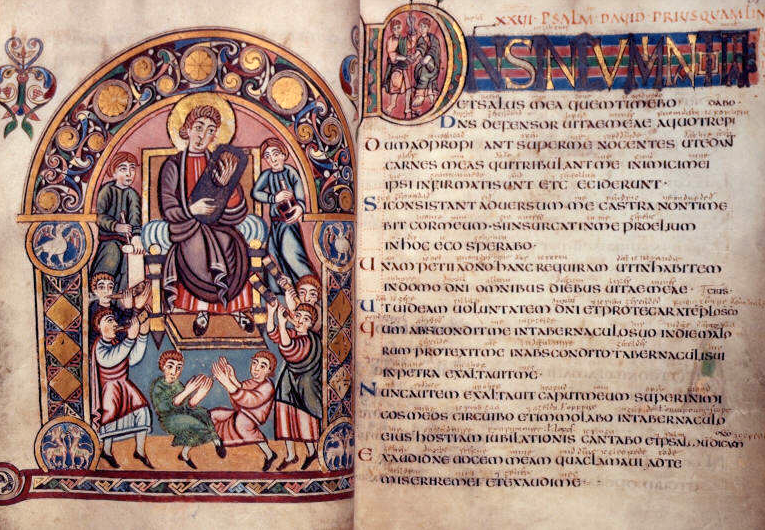
The rights of the Empire proved from the Bible
Very singular are the reasonings used by which the necessity and divine right of the Empire are proved out of the Bible. The mediæval theory of the relation of the civil power to the priestly was profoundly influenced by the account in the Old Testament of the Jewish theocracy, in which the king, though the institution of his office was a derogation from the purity of the older system, appears divinely chosen and commissioned, and stood in a peculiarly intimate relation to the national religion. From the New Testament the authority and eternity of Rome herself was established. Every passage was seized on where submission to the powers that be is enjoined, every instance cited where obedience had actually been rendered to imperial officials, a special emphasis being laid on the sanction which Christ Himself had given to Roman dominion by pacifying the world through Augustus, by being born at the time of the taxing, by paying tribute to Cæsar, by saying to Pilate, ‘Thou couldest have no power at all against Me except it were given thee from above.’
More attractive to the mystical spirit than these direct arguments were those drawn from prophecy, or based on the allegorical interpretation of Scripture. Very early in Christian history had the belief formed itself that the Roman Empire—as the fourth beast of Daniel’s vision, as the iron legs and feet of Nebuchadnezzar’s image—was to be the world’s last and universal kingdom. From Origen and Jerome downwards it found unquestioned acceptance, and that not unnaturally. For no new power had arisen to extinguish the Roman, as the Persian monarchy had been blotted out by Alexander, as the realms of his successors had fallen before the conquering republic herself. Every Northern conqueror, Goth, Lombard, Burgundian, had cherished her memory and preserved her laws; Germany had adopted even the name of the Empire ‘dreadful and terrible and strong exceedingly, and diverse from all that were before it.’ To these predictions, and to many others from the Apocalypse, were added those which in the Gospels and Epistles foretold the advent of Antichrist. He was to succeed the Roman dominion, and the Popes are more than once warned that by weakening the Empire they are hastening the coming of the enemy and the end of the world. It is not only when groping in the dark labyrinths of prophecy that mediæval authors are quick in detecting emblems, imaginative in explaining them. Men were wont in those days to interpret Scripture in a singular fashion. Not only did it not occur to them to ask what meaning words had to those to whom they were originally addressed; they were quite as careless whether the sense they discovered was one which the language used would naturally and rationally bear to any reader at any time. No analogy was too faint, no allegory too fanciful, to be drawn out of a simple text; and, once propounded, the interpretation acquired in argument all the authority of the text itself. Thus the two swords of which Christ said, ‘It is enough,’ became the spiritual and temporal powers, and the grant of the spiritual to Peter involves the supremacy of the Papacy. Thus one writer proves the eternity of Rome from the seventy-second Psalm, ‘They shall fear thee as long as the sun and moon endure, throughout all generations;’ the moon being of course, since Gregory VII, the Roman Empire, as the sun, or greater light, is the Popedom. Another quoting, ‘Qui tenet teneat donec auferatur,’ with Augustine’s explanation thereof, says, that when ‘he who letteth’ is removed, tribes and provinces will rise in rebellion, and the Empire to which God has committed the government of the human race will be dissolved. From the miseries of his own time (he wrote under Frederick III) he predicts that the end is near. The same spirit of symbolism seized on the number of the electors: ‘the seven lamps burning in the unity of the sevenfold spirit which illumine the Holy Empire.’ Strange legends told how Romans and Germans were of one lineage; how Peter’s staff had been found on the banks of the Rhine, the miracle signifying that a commission was issued to the Germans to reclaim wandering sheep to the one fold. So complete does the scriptural proof appear in the hands of mediæval churchmen, many holding it a mortal sin to resist the power ordained of God, that we forget they were all the while only adapting to an existing institution what they found written already; we begin to fancy that the Empire was maintained, obeyed, exalted for centuries, on the strength of words to which we attach in almost every case a wholly different meaning.
Illustrations from Mediæval Art
It would be a task both pleasant and profitable to pass on from the theologians to the poets and artists of the Middle Ages, and endeavour to trace through their works the influence of the ideas which have been expounded above. But it is one far too wide for the scope of the present treatise; and one which would demand an acquaintance with those works themselves such as only minute and long-continued study could give. For even a slight knowledge enables any one to see how much still remains to be interpreted in the imaginative literature and in the paintings of those times, and how apt we are in glancing over a piece of work to miss those seemingly trifling indications of the artist’s thought or belief which are all the more precious that they are indirect or unconscious. Therefore a history of mediæval art which shall evolve its philosophy from its concrete forms, if it is to have any value at all, must be minute in description as well as subtle in method. But lest this class of illustrations should appear to have been wholly forgotten, it may be well to mention here two paintings in which the theory of the mediæval empire is unmistakeably set forth. One of them is in Rome, the other in Florence; every traveller in Italy may examine both for himself.
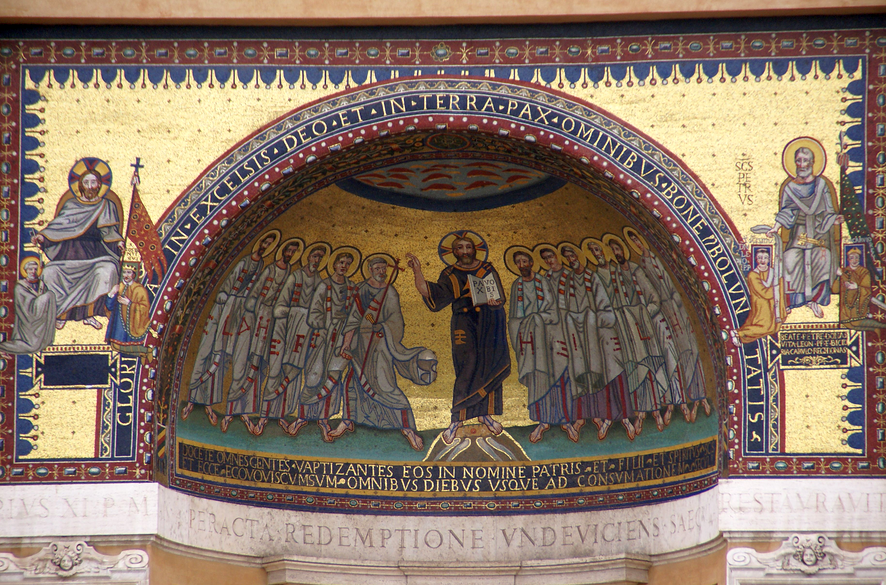
Mosaic of the Lateran Palace at Rome
The first of these is the famous mosaic of the Lateran triclinium, constructed by Pope Leo III about A.D. 800, and an exact copy of which, made by the order of Sextus V, may still be seen over against the façade of St. John Lateran. Originally meant to adorn the state banqueting-hall of the Popes, it is now placed in the open air, in the finest situation in Rome, looking from the brow of a hill across the green ridges of the Campagna to the olive-groves of Tivoli and the glistering crags and snow-capped summits of the Umbrian and Sabine Apennine. It represents in the centre Christ surrounded by the Apostles, whom He is sending forth to preach the Gospel; one hand is extended to bless, the other holds a book with the words ‘Pax Vobis.’ Below and to the right Christ is depicted again, and this time sitting: on his right hand kneels Pope Sylvester, on his left the Emperor Constantine; to the one he gives the keys of heaven and hell, to the other a banner surmounted by a cross. In the group on the opposite, that is, on the left side of the arch, we see the Apostle Peter seated, before whom in like manner kneel Pope Leo III and Charles the Emperor; the latter wearing, like Constantine, his crown. Peter, himself grasping the keys, gives to Leo the pallium of an archbishop, to Charles the banner of the Christian army. The inscription is, ‘Beatus Petrus dona vitam Leoni PP et bictoriam Carulo regi dona;’ while round the arch is written, ‘Gloria in excelsis Deo, et in terra pax omnibus bonæ voluntatis.’
The order and nature of the ideas here symbolized is sufficiently clear. First comes the revelation of the Gospel, and the divine commission to gather all men into its fold. Next, the institution, at the memorable era of Constantine’s conversion, of the two powers by which the Christian people is to be respectively taught and governed. Thirdly, we are shewn the permanent Vicar of God, the Apostle who keeps the keys of heaven and hell, re-establishing these same powers on a new and firmer basis. The badge of ecclesiastical supremacy he gives to Leo as the spiritual head of the faithful on earth, the banner of the Church Militant to Charles, who is to maintain her cause against heretics and infidels.
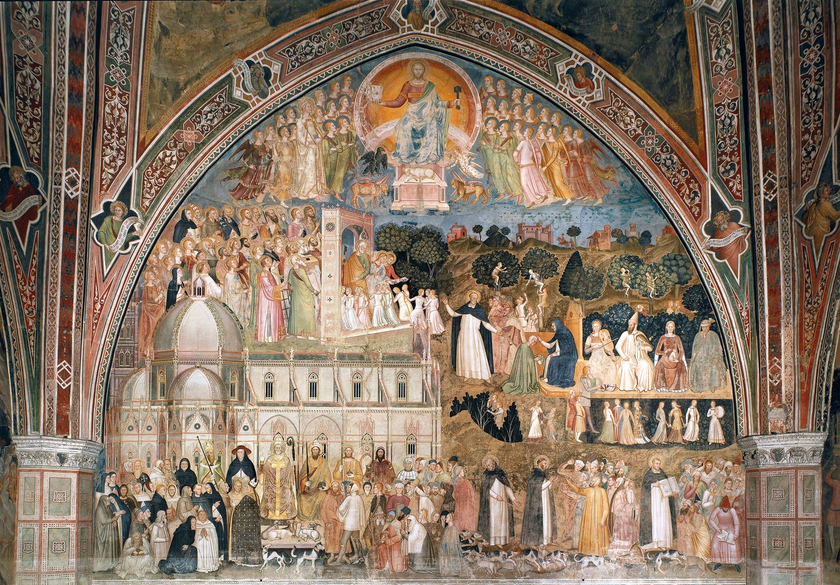
Fresco in S. Maria Novella at Florence
The second painting is of greatly later date. It is a fresco in the chapter-house of the Dominican convent of Santa Maria Novella at Florence, usually known as the Capellone degli Spagnuoli. It has been commonly ascribed, on Vasari’s authority, to Simone Martini of Siena, but an examination of the dates of his life seems to discredit this view. Most probably it was executed between A.D. 1340 and 1350. It is a huge work, covering one whole wall of the chapter-house, and filled with figures, some of which, but seemingly on no sufficient authority, have been taken to represent eminent persons of the time—Cimabue, Arnolfo, Boccaccio, Petrarch, Laura, and others. In it is represented the whole scheme of man’s life here and hereafter—the Church on earth and the Church in heaven. Full in front are seated side by side the Pope and the Emperor: on their right and left, in a descending row, minor spiritual and temporal officials; next to the Pope a cardinal, bishops, and doctors; next to the Emperor, the king of France and a line of nobles and knights. Behind them appears the Duomo of Florence as an emblem of the Visible Church, while at their feet is a flock of sheep (the faithful) attacked by ravening wolves (heretics and schismatics), whom a pack of spotted dogs (the Dominicans) combat and chase away. From this, the central foreground of the picture, a path winds round and up a height to a great gate where the Apostle sits on guard to admit true believers: they passing through it are met by choirs of seraphs, who lead them on through the delicious groves of Paradise. Above all, at the top of the painting and just over the spot where his two lieutenants, Pope and Emperor, are placed below, is the Saviour enthroned amid saints and angels.
Anti-national character of the Empire
Here, too, there needs no comment. The Church Militant is the perfect counterpart of the Church Triumphant: her chief danger is from those who would rend the unity of her visible body, the seamless garment of her heavenly Lord; and that devotion to His person which is the sum of her faith and the essence of her being, must on earth be rendered to those two lieutenants whom He has chosen to govern in His name.
A theory, such as that which it has been attempted to explain and illustrate, is utterly opposed to restrictions of place or person. The idea of one Christian people, all whose members are equal in the sight of God,—an idea so forcibly expressed in the unity of the priesthood, where no barrier separated the successor of the Apostle from the humblest curate,—and in the prevalence of one language for worship and government, made the post of Emperor independent of the race, or rank, or actual resources of its occupant. The Emperor was entitled to the obedience of Christendom, not as hereditary chief of a victorious tribe, or feudal lord of a portion of the earth’s surface, but as solemnly invested with an office. Not only did he excel in dignity the kings of the earth: his power was different in its nature; and, so far from supplanting or rivalling theirs, rose above them to become the source and needful condition of their authority in their several territories, the bond which joined them in one harmonious body. The vast dominions and vigorous personal action of Charles the Great had concealed this distinction while he reigned; under his successors the imperial crown appeared disconnected from the direct government of the kingdoms they had established, existing only in the form of an undefined suzerainty, as the type of that unity without which men’s minds could not rest. It was characteristic of the Middle Ages, that demanding the existence of an Emperor, they were careless who he was or how he was chosen, so he had been duly inaugurated; and that they were not shocked by the contrast between unbounded rights and actual helplessness. At no time in the world’s history has theory, pretending all the while to control practice, been so utterly divorced from it. Ferocious and sensual, that age worshipped humility and asceticism: there has never been a purer ideal of love, nor a grosser profligacy of life.
The power of the Roman Emperor cannot as yet be called international; though this, as we shall see, became in later times its most important aspect; for in the tenth century national distinctions had scarcely begun to exist. But its genius was clerical and old Roman, in nowise territorial or Teutonic: it rested not on armed hosts or wide lands, but upon the duty, the awe, the love of its subjects.

